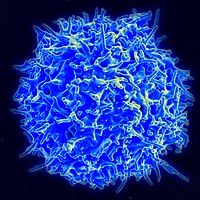
Photo from wikipedia
Loss of pancreatic β–cell is a critical factor in the pathogenesis of type 1 diabetes and it also occurs in type 2. TXNIP (thioredoxin – interacting protein), also known as… Click to show full abstract
Loss of pancreatic β–cell is a critical factor in the pathogenesis of type 1 diabetes and it also occurs in type 2. TXNIP (thioredoxin – interacting protein), also known as vitamin D3-upregulated protein 1, or thioredoxin-binding-protein-2, regulates this process and modulates cellular redox balance. TXNIP is localized primarily in the nucleus, but under oxidative stress it moves to mitochondria, where it interacts with mitochondrial thioredoxin 2. Overexpression of TXNIP induced by hyperglycaemia is typical for diabetes and insulin resistance and leads to apoptosis of pancreatic β–cell, cardiomyopathy, metabolic disorders and multiple harmful effects. It activates NLRP3 inflamasomme and IL–1β, a cytokine involved in type 2 diabetes and insulin resistance. TXNIP influences peroxisome proliferator-activated receptor alpha transcriptional activity, expression of glucose transporter–1, nitric oxide production in endothelium and insulin production in β–cells. TXNIP overexpression leads to diabetic retinopathy, nephropathy, atherosclerosis, it occurs in cancers and autoimmune diseases, while its deficiency protects β cells. Reduction of TXNIP is an important target in diabetes treatment. In this mechanism insulin, metformin and inhibitors of dipeptydylopeptydase IV are involved. It has been observed that calcium channel blockers (CCB) used in hypertension also inhibit TXNIP expression in cardiomyocytes. L–type channels identification in pancreatic β-cells revealed that CCB inhibit TXNIP expression also in β–cells. For the first time, verapamil was distinguished as an agent that not only inhibits TXNIP expression in pancreatic β-cells, but also enhances β cell survival and function, and possibly prevents diabetes.
Journal Title: Medicine and Pharmacy Reports
Year Published: 2022
Link to full text (if available)
Share on Social Media: Sign Up to like & get
recommendations!